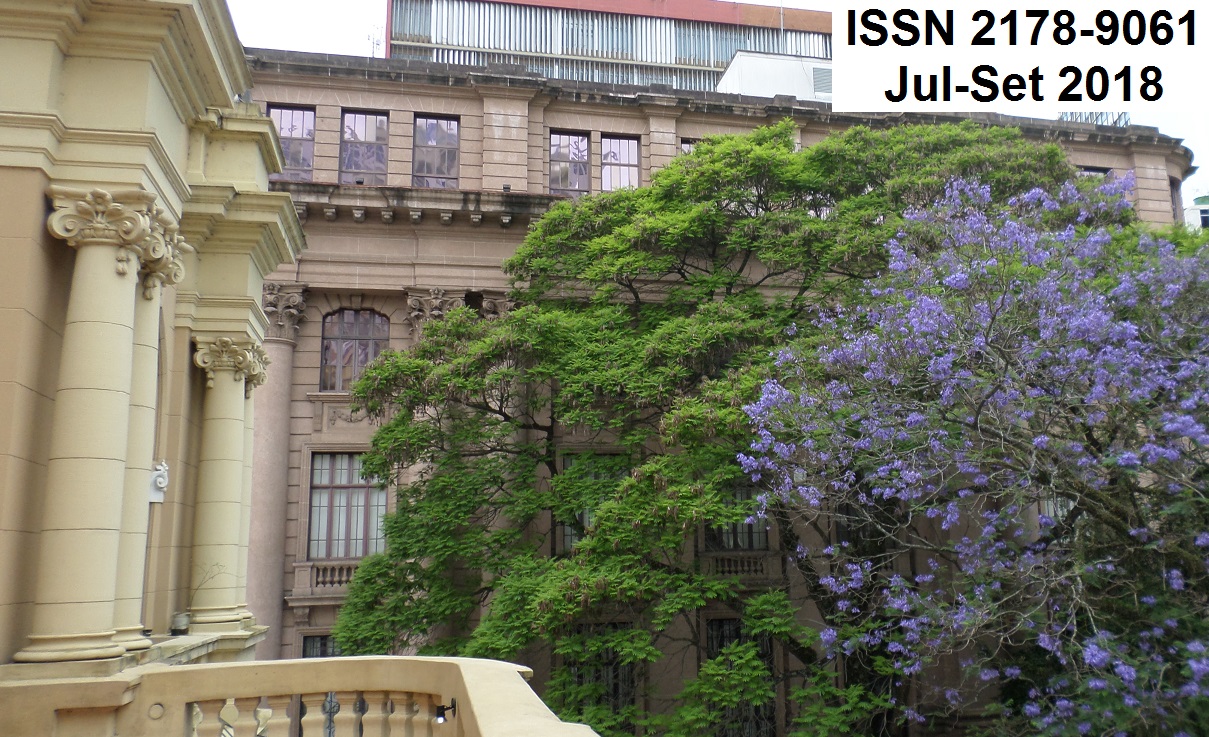Conflicts and Management Perceptions Between Native and Non-Native Residents of Four Beaches in Ecuador / Conflitos e Percepção de Residentes Nativos e Não Nativos em Relação ao Manejo Ambiental em Quatro Praias do Equador
Palavras-chave:
Tourism. Turismo. Beach Tourism. Turismo de Sol-e-Mar. Resident. Residente. Ecuador. Equador.Resumo
ABSTRACT
By conducting an exploratory research, 705 surveys were collected along four sandy beaches in Ecuador: Ayangue, Chipipe, Olon and Puerto Engabao, chosen because of their unequal levels of tourism development. A correlation study takes into account the perception of native and non-native residents and as a result environmental conflicts affected most residents from Ayangue, Olon and Puerto Engabao, and physical conflicts mainly affected residents from Chipipe. Also, according to the perceptions of native and non-native residents on beach management, only in Olon both groups considerate a community management while in the other beaches, the preferences varied between national, regional and community management. Finally, the Chi-Square tests show non-relation between the conflicts and the place of origin. However, in terms of management, there is significant relation between this aspect and their native land. This study aims to contribute to beach management research considering residents as a heterogeneous group.
KEYWORDS
Tourism. Beach Tourism. Resident. Ecuador.
RESUMO
A presente pesquisa, exploratória com 705 questionários respondidos, foi aplicada em quatro praias do Equador - Ayangue, Chipipe, Olon e Puerto Engabao -, escolhidas considerando-se seus níveis desiguais de desenvolvimento turístico. Estudo de correlação levou em consideração a percepção dos residentes nativos e não-nativos e, como resultado, constatou-se que conflitos ambientais afetaram a maioria dos moradores de Ayangue, Olon e Puerto Engabao, e conflitos sociais afetaram principalmente os moradores de Chipipe. Além disso, de acordo com as percepções dos residents, nativos e não nativos, sobre o manejo das praias, somente em Olon ambos os grupos consideram a possibilidade de um manejo comunitário, enquanto nas demais, as preferências variaram entre manejo federal, regional e comunitário. Por fim, o Qui-Quadrado mostrou não-relação entre os conflitos e o local de origem. No entanto, em termos de gestão, existe uma relação significativa entre este aspecto e a terra natal dos sujeitos. Este estudo visa contribuir para a pesquisa sobre manejo de praias, considerando os moradores como um grupo heterogêneo.
PALAVRAS-CHAVE
Turismo. Turismo de Sol-e-Mar. Residente. Equador.
AUTORAS
Fanny Manner-Baldeon – Mestra. Professora e pesquisadora na Universidad de Especialidades Espíritu Santo, Samborondon, Guayas, Ecuador. Currículo: https://orcid.org/0000-0003-0946-0890. E-mail: fannymanner@yahoo.com[1]María Fernanda Icaza-Moran – Escuela Superior Politécnica del Litoral, Guayaquil, Equador. E-mail: mficaza@espol.edu.ec
REFERENCIAS
Aaker, J. & Schmitt, B. (2001). Culture-dependent assimilation and differentiation of the self: preferences for consumption symbols in the United States and China. Journal of Cross Cultural Psychology, 32(5), 561-576. Link
Andereck, K. L., & Nyaupane, G. P. (2010). Exploring the nature of tourism and quality of life perceptions among residents. Journal of Travel Research, 50(3), 248-260. Link
Biggs, D., Hall, C. M., & Stoeckl, N. (2012). The resilience of formal and informal tourism enterprises to disasters: reef tourism in Phuket, Thailand. Journal of Sustainable Tourism, 20(5), 645-665. Link
Botero, C. & Hurtado, Y. (2009). Tourist Beach Sorts as a classification tool for integrated beach management in Latin America. International Approaches of Coastal Research in Theory and Practice Coastline Reports, 13, 133-142. Link
Bowen, R. & Riley, C. (2003). Socio-economic indicators and integrated coastal management. Ocean & Coastal Management, 46 (1), 299-312. Link
Breton, F., Clapes, J., Marques, A. & Priestle, G. K. (1996). The recreational use of beaches and consequences for the development of new trends in management: the case of the beaches of the metropolitan region of Barcelona (Catalonia, Spain). Ocean & Coastal Management, 32(3), 153-180. Link
Brunt, P. & Courtney, P. (1999). Host perceptions of sociocultural impacts. Annals of Tourism Research, 26(3), 493-515. Link
Bestard, A. B. & Nadal, J. R. (2007). Modelling environmental attitudes toward tourism. Tourism Management, 28(3), 688-695. Link
Cervantes, O., Espejel, I., Arellano, E. & Delhumeau, S. (2008). Users’ perception as a tool to improve urban beach planning and management. Journal of Environmental Management, 42(2), 249-264. Link
Concu, N. & Atzenib, G. (2011). Conflicting preferences among tourists and residents. Tourism Management, 33(6), 1293-1300. Link
Coser, L. A. (1956). The functions of social conflict. London: Routledge.
Moscoso, A. P. D., Loyola, J. I. L. & Quijano, C. R. (2009). Creación de un manual que permita medir la presión en centros turísticos de playa en el Ecuador: caso Salinas. Monografia, Faculdad de Ingeniería Marítima y Ciencias del Mar, Escuela Superior Politécnica del Litoral. Link
Diedrich, A. & García -Buades, E. (2009). Local perceptions of tourism as indicators of destination decline. Tourism Management, 30(4), 512 -521. Link
Gari, S. R., Newton, A. & Icely, J. D. (2014). A review of the application and evolution of the DPSIR framework with an emphasis on coastal social-ecological systems. Ocean & Coastal Management, 103(1), 63-77. Link
Gheskierea, T., Vincx, M., Urban-Malinga, B., Rossano, C., Scapini F. & Degraera S. (2005) Nematodes from wave-dominated sandy beaches: diversity, zonation patterns and testing of the isocommunities concept. Estuarine Coastal and Shelf Science, 62(1), 365-375. Link
Hall, C. M. (2001). Trends in ocean and coastal tourism: the end of the last frontier?. Ocean & Coastal Management, 44(9-10), 601-618. Link
Honey, M. & Krantz, D. (2007). Global trends in coastal tourism. Washington D.C.: Marine Program World Wildlife Fund. Link
Jennings, S. (2004). Coastal tourism and shoreline management. Annals of Tourism Research, 31(4), 899-922. Link
Ko, D. W. & Stewart, W. P. (2002). A structural equation model of residents' attitudes for tourism development. Tourism Management, 23(5), 521-530. Link
Lankford, S. V. (1994). Attitudes and perceptions toward tourism and rural regional development. Journal of Travel Research, 32(3), 35-43. Link
Lindberg, K. & Johnson, R. L. (1997). Modeling resident attitudes toward tourism. Annals of Tourism Research, 24(2), 402-424. Link
López-Hernández, F. & Mercader, S. (2015). Perceived impact of tourism by the resident population in Torrevieja: national versus non-national residents, Spain. European Journal of Tourism Research, 10(1), 120-126. Link
Lozoya, J., Sardá, R. & Jiménez, J. (2014). Users expectations and the need for differential beach management frameworks along the Costa Brava: urban vs. natural protected beaches. Land Use Policy, 38(1), 397-414. Link
Maguire, G., Miller, K., Weston, M. & Young, K. (2011). Being beside the seaside: Beach use and preferences among coastal residents of south-eastern Australia. Ocean & Coastal Management, 54(1), 781–788. Link
Marin, V., Palmisani, F., Ivaldi, R., Dursi, R. & Fabiano, M. (2009). Users’ perceptions analyses for sustainable beach management in Italy. Ocean & Coastal Management, 52(5), 268-277. Link
Mason, P. & Cheyne, J. (2000). Residents attitudes to proposed tourism development. Annals of Tourism Research, 27(2), 391-411. Link
McLachlan, A., Defeo, O., Jaramillo, E. & Short, A. (2013). Sandy beach conservation and recreation: Guidelines for optimizing management strategies for multi-purpose use. Ocean & Coastal Management, 71(1), 250-268. Link.
McLachlan, R., Gilfillan, G. & Gordon, J. (2013). Deep and Persistent Disadvantage in Australia. Camberra, Australia. Australian Government Productivity Commission Staff Working Paper. Link
Micallef, A. & Williams, A. (2004). Application of a novel approach to beach classification in the Maltese Islands. Ocean & Coastal Management, 47(5/6), 225-242. Link
Ministerio de Turismo del Ecuador. (2007). Plan Estratégico de Desarrollo Sostenible del Turismo, Plandetur 2020. Quito: Tourism and Leisure Consulting Group. Link
Oh C., Draper, J. & Dixon, A. (2010). Comparing resident and tourist preferences for public beach access and related amenities. Ocean & Coastal Management, 53(5/6), 245-251. Link
Ojeda-Martínez, C., Casalduero, F. G., Bayle-Sempere, J. T., Cebrian, C. B., Valle, C., Sanchez-Lizaso, J. L. & Salas, F. (2009). A conceptual framework for the integral management of marine protected areas. Ocean & Coastal Management, 52(2), 89-101. Link
Paksoy, P. & Çolakoğlu, N. (2014). Beach management & analysis of visitors’ remarks, Turkey. International Journal of Research in Business and Social Science, 3(30). Link
Phillips, M., & House, C. (2009). An evaluation of priorities for beach tourism: Case studies from South Wales, UK. Tourism Management, 30(2), 176-183. Link
Roca, E., Villares, M. & Ortego, M. (2009). Assessing public perceptions on beach quality according to beach users’ profile: A case study in the Costa Brava (Spain). Tourism Management 30(2) 598-607. Link
Roig-Munar, F. X., Martín-Prieto, J. A., Rodríguez-Perea, A., Pons, G. X., Gelabert, B. & Mir-Gual, M. (2012). Risk assessment of beach-dune system erosion: beach management impacts on the Balearic Islands. Journal of Coastal Research, 28(6), 1488-1499. Link
Sheldon, P. J. & Abenoja, T. (2001) Resident attitudes in a mature destination: the case of Waikiki. Tourism Management, 22(5), 435-443. Link
Simmel, G. (1955). Conflict. New York: Free Press.
Sinkovicz, R. & Penz, E. (2009). Social distance between residents and international tourists--Implications for international business. International Business Review, 18(5), 457-469. Link
Smith, P. & Bond, M. (1999). Social psychology across cultures. Allyn & Bacon: Needham Heights.
Tudor, D. T. & Williams, A. T. (2006). A rationale for beach selection by the public on the coast of Wales, UK. Area, 38(2), 153-164. Link
United Nations World Tourism Organization (2010). Sustainable tourism governance and management in coastal areas of Africa. Madrid: UNWTO. Link
United Nations Environment Programme (2009). Sustainable Coastal tourism: An integrated planning and management approach. Paris: Unep. Link
Vaz, B., Pereira Da Silva, C., Phillips M. & Williams, A. (2009). The importance of user’s perception for beach management, Portugal. Journal of Coastal Research, 56(1), 1161-1168. Link
Veal, A. (2006). Research methods for leisure and tourism: a practical guide. New York: Prentice Hall, Financial Times.
Villares, M., Roca, E., Serra, J. & Montori, C. (2006). Social perception as a tool for beach planning: a case study on the Catalan coast. Journal of Coastal Research, 48(1), 118-123. Link
Wesley, A. & Pforr, C. (2010). The governance of coastal tourism: Unraveling the layers of complexity at Smiths Beach, Western Australia. Journal of Sustainable Tourism, 18(6), 773-792. Link
Williams, A., Micallef, A., Anfuso, G. & Gallego-Fernandez, J. (2011). Andalusia, Spain: an assessment of coastal scenary. Landscape Research, 37(3), 327-349. Link
Xie, H., Bao, J. & Kerstetter, D. (2012). Examining the effects of tourism impacts on satisfaction with tourism between native and non-native residents. International Journal of Tourism Research, 16(1), 241-249. Link
Processo Editoral: Recebido: 13 MAR 2018; Avaliado: MAR; Aceite: 9 ABR 2018
Downloads
Publicado
Como Citar
Edição
Seção
Licença
Autores que publicam nesta revista concordam com os seguintes termos:
Os Autores mantém os direitos autorais e concedem à revista o direito de primeira publicação, com o trabalho simultaneamente licenciado sob a Creative Commons Attribution License que permitindo o compartilhamento do trabalho com reconhecimento da autoria do trabalho e publicação inicial nesta revista.
Autores têm autorização para assumir contratos adicionais separadamente, para distribuição não-exclusiva da versão do trabalho publicada nesta revista (ex.: publicar em repositório institucional ou como capítulo de livro), com reconhecimento de autoria e publicação inicial nesta revista.
Autores têm permissão e são estimulados a publicar e distribuir seu trabalho online (ex.: em repositórios institucionais ou na sua página pessoal) a qualquer ponto antes ou durante o processo editorial, já que isso pode gerar alterações produtivas, bem como aumentar o impacto e a citação do trabalho publicado (Veja O Efeito do Acesso Livre).








